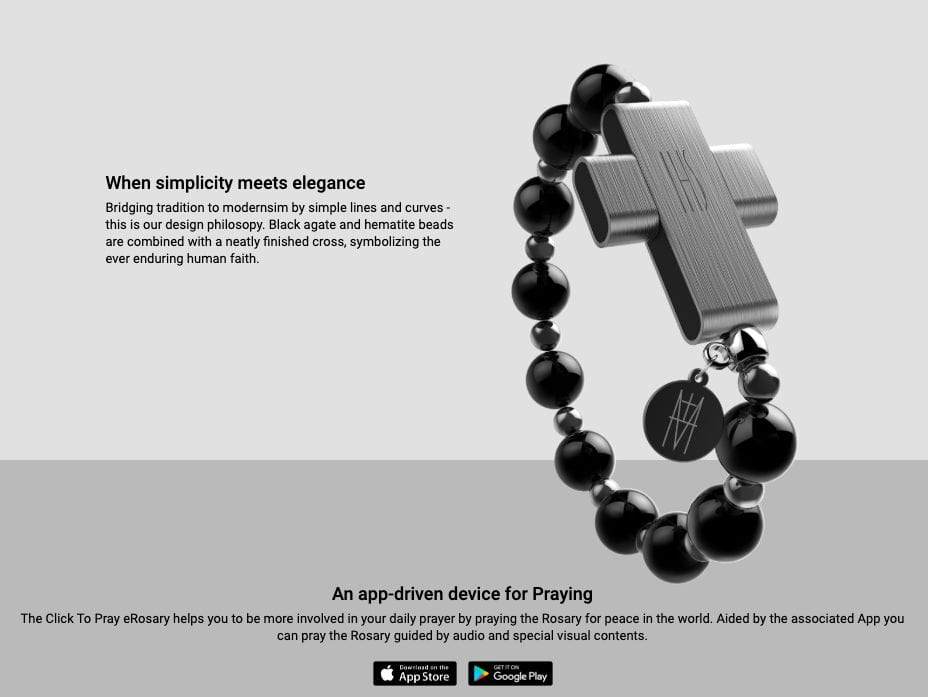
David Rutland dives down the rabbit hole of religious technology and technofetishism. Does he disappear off the deep end?
VATICAN CITY, 2019
In a four-story sandstone building a stone’s throw away from St Peter’s square in Rome, the numbers are going up.
Every prayer made by thousands of Catholics across the world is being registered, one gloss black rosary bead at a time, on Vatican servers. The Christian bible fails to mention whether the holy spirit is familiar with SQL databases, but for many, this is a direct line to their god, and a personal record of their piety.
Religion is supposed to be dead by now. As the much-maligned opium of the masses it has been replaced piecemeal by television, by sports, by celebrities, by pornography, and by the ever-present and insistent god in your pocket.
But reports of the Catholic church’s demise have been greatly exaggerated. In 1910, 18% of the global population counted themselves as Catholics. A century later that figure had shrunk to 17% – a share drop of 5.5%, masked by net acquisition of 809 million souls. It’s still an awful lot of people.
Worldwide, the Catholic population has tended to drop in regions where income inequality is less pronounced, such as Europe and South America**, while surging upwards in sub-saharan Africa and North America*. In the US, Catholics now account for more than a fifth of the population.
It makes sense. In a country which seems fundamentally unfair, where the education system is literally crumbling, and where falling ill can ruin your life, religion provides hope to the hopeless, and gives them the fortitude to carry on.
But this is the age of distraction. Of fitbits and companion apps, of push notifications, and of the conditioned compulsion to check your portable Skinner box on a regular basis. The age of technological fetishism where gadgetry is worshipped, and where worshippers are willing to camp all night on the streets for a chance at handing over their money for the latest shiny hardware to keep them always connected and always on.
How can the oldest institution in the western world, with its damp, dusty, and dilapidated buildings, cope against a shiny, virginal white, scratchproof future which is always nearby, and always available? God may or may not be listening, but Siri and Alexa know your deepest secrets and darkest desires.

Enter The Virtual Rosary
Virtual rosary apps have been available for a long time, and there are more than 250 to choose from on Google’s app store. Tasbih counters – the Islamic equivalent of rosary beads – are available in equal numbers***.
And these aren’t trash apps either. The more popular versions have millions of downloads and offer help with particular prayers, biblical references, and, of course, keeping count. They have tens of thousands of five star reviews.
But these apps, worthy as they may be, are missing some crucial elements. Where is the tactile experience of coarse wooden beads slipping through penitent fingers, being worn smooth by repetition over the years?
Where is the monogrammed, brushed steel, tubular crucifix to dangle from the penitent wrist?
Where is the ability to connect, personally, to Pope Francis through his Worldwide Prayer Network?
More importantly, where is the built in step counter?
“Aimed at the peripheral frontiers of the digital world where the young people dwell, the Click To Pray eRosary serves as a technology-based pedagogy to teach the young how to pray the Rosary, how to pray it for peace, how to contemplate the Gospel.”

The beads are flawless black agate and hematite in place of the more traditional wood or plastic, and the cross, which resembles nothing quite so much as a swivel type USB stick, symbolises, “the ever enduring human faith.” Yes. It does have a step counter – superbly useful for those long pilgrimages to faraway holy sites.
A silly and juvenile comparison which is unworthy of us (and possibly blasphemous).
The beads and the ‘Click To Pray’ companion app can be automatically activated by making the sign of the cross, and each prayer or rosary is counted, with the data stored remotely – in the cloud.

THE QUESTIONABLE EFFECTIVENESS OF PRAYER?
And this is where the concept gets interesting. The effectiveness of prayer has never been scientifically proven. How could it be? Miracles are notoriously difficult to verify, and the Vatican has a long, drawn out process by which it uses prayers and substantiated miracles to determine whether or not a given individual has made it past the pearly gates, and is in a position to intercede with heaven.
There are a lot of uncertainties. Who prayed for a particular outcome? To whom did they pray? Did they pray to anyone else or for any other cause? Does it require a certain number of prayers or a certain number of people? These are the unknowables that can mean the difference between sainthood and mere veneration.
Thanks to eRosary, religion and prayer now exist within a technological framework, and these things can be measured. The daily prayers pushed to worshippers through Click to Pray could be tailored towards a particular outcome or diverted via a particular saint, and the verified prayers of the faithful totted up behind the sandstone edifice on Borgo Santo Spirito. The results would be scrutinised methodically by the Pope’s finest data analysts, probing for patterns, checking medical records, and keeping an eye on their Google alerts feed for particular events.
Could it be proved that medical miracles, such as the remission of an aggressive and incurable cancer, can be brought about by the sincere wishful thinking of a few family members?
What if all of the thoughts and prayers which flood Facebook after a tragedy such as Sandy Hook could be converted to actual prayers towards a specific end. Christians believe that Jesus brought the dead back to life, and Catholics believe that saints possess that same ability.
How many thoughts and prayers would it take to resurrect a teenager killed in a car crash? Or an entire class of first graders? To whom are the prayers best directed? Do they need to be simultaneous or will it still work if a million prayers are scattered over the course of a week? The data, faithfully gathered by the eRosary, will tell us.
This is, of course, assuming that the Click to Pray software isn’t hijacked for nefarious purposes. Security on the digital rosary is woeful, and a week after its launch, the gadget was declared to be eminently hackable by consulting firm, Fidus Information Security, who, “in just 10 minutes found some glaring issues.”
HACKING THOSE HEAVENLY GATES
At cyberPunks.com, we respect all faiths, although we are somewhat on the fence as to whether or not prayer works at all.
But imagine if it did.
Imagine hackers subverting the co-ordinated prayers of millions to thwart an invasion, or for an enemy nation’s crops to fail. Imagine typhoons blowing up out of nowhere to wreck China’s vast high seas fleet, or North Korea suddenly disappearing from the face of the earth.
And there’s no reason this technology need be restricted to Catholics, or even confined to Christians. The data it gathers, and the prayers and miracles it generates could be used by followers of any religion.
Imagine holy war fought with actual gods.
I think I’ve just found the premise of my next book.
NOTES
* The GINI coefficient of wealth distribution places the US as the fifth most unequal (least equal?) country in the world.
**Brazil – historically the most Catholic country in the world, is currently ranked as the 10th least unequal nation, and saw a 10% drop in practicing Catholics between 2014 and 2016
*** There may be many more, but the play store search engine caps results at 250.
